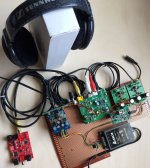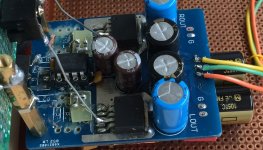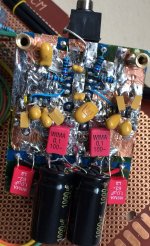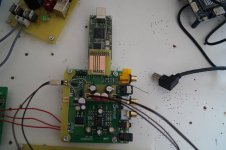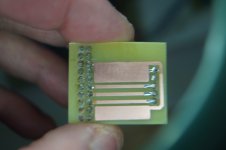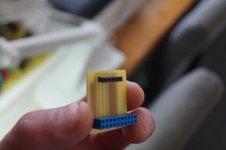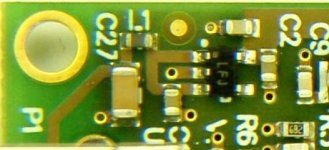Promised some photos to show how the test setup is looking these days and to offer a look at the modified headphone amp.
The headphone amp has a number of modifications as can be seen in the attached photos. On the bottom of the board, mylar tape was put across all the traces to insulate them, then adhesive-backed copper foil was cut and put in place, and the pieces soldered together. Tantalum and ceramic bypass caps were added at each IC. Those caps are mainly there to assure stability, freedom from power supply related oscillations, and reliable operation.
However, if you look at the test setup picture I also have some Twisted Pear LME49600 headphone amp mono-blocks for sound quality comparison. They are hard to beat for stereo separation, which was what prompted me to add the film caps and extra 1000uf electrolytics on the bottom of my modified board. Now stereo separation is very close to the mono-blocks.
My modified headphone amp and the Twisted Pear boards also differ in that the latter are optimized for unconditional stability with a capacitive load and mine are optimized for lowest distortion. So long as the power supply is clean, and the DAC has been modified to produce very low distortion, I prefer the accuracy of my low distortion version. For example, cymbal tails sound cleaner to me with it, but if power or DAC quality is poor, you will hear it for sure. The Twisted Pear headphone amps seem to be more forgiving and sound better to me when everything else isn't just right. That is my personal opinion only, of course.
I also showed the Sennheiser HD-600 headphones I am using. That model has been used for mixing and in mastering rooms for many years by many different people. I recommend them for good sound quality when listening to a reproduction system of the quality we are going for here. Unfortunately, they are not cheap but that is the way it is with transducers, good ones cost a lot to make. Don't know any cheap way to get around that.
The headphone amp has a number of modifications as can be seen in the attached photos. On the bottom of the board, mylar tape was put across all the traces to insulate them, then adhesive-backed copper foil was cut and put in place, and the pieces soldered together. Tantalum and ceramic bypass caps were added at each IC. Those caps are mainly there to assure stability, freedom from power supply related oscillations, and reliable operation.
However, if you look at the test setup picture I also have some Twisted Pear LME49600 headphone amp mono-blocks for sound quality comparison. They are hard to beat for stereo separation, which was what prompted me to add the film caps and extra 1000uf electrolytics on the bottom of my modified board. Now stereo separation is very close to the mono-blocks.
My modified headphone amp and the Twisted Pear boards also differ in that the latter are optimized for unconditional stability with a capacitive load and mine are optimized for lowest distortion. So long as the power supply is clean, and the DAC has been modified to produce very low distortion, I prefer the accuracy of my low distortion version. For example, cymbal tails sound cleaner to me with it, but if power or DAC quality is poor, you will hear it for sure. The Twisted Pear headphone amps seem to be more forgiving and sound better to me when everything else isn't just right. That is my personal opinion only, of course.
I also showed the Sennheiser HD-600 headphones I am using. That model has been used for mixing and in mastering rooms for many years by many different people. I recommend them for good sound quality when listening to a reproduction system of the quality we are going for here. Unfortunately, they are not cheap but that is the way it is with transducers, good ones cost a lot to make. Don't know any cheap way to get around that.
Attachments
Last edited:
Link, please.
ES9038Q2M ES9038 I2S Input amplifier Decoders Mill Board DAC Decoding Board -in Amplifier from Consumer Electronics on Aliexpress.com | Alibaba Group
I'll report back to you when I know more.
Thanks.ES9038Q2M ES9038 I2S Input amplifier Decoders Mill Board DAC Decoding Board -in Amplifier from Consumer Electronics on Aliexpress.com | Alibaba Group
I'll report back to you when I know more.

As I can see, this board has separate PSU for digital and analog stage. How good/bad are they?
@vacuphile, Maybe a problem in that I don't see where there are jumpers on that board? Maybe I am missing them, but if none how could one set the right reconstruction filter?
Will this Amanero board work? It has been through a group buy on this forum years ago and has been well documented aswell. I also found a forum that said it worked with Android. It's possible to run it with external regulator and they have some software tools for it on the amanero site. They use good clocks for this price point too. Amanero Technologies
Amanero board would probably work. Depends on what you want to do though. I am recommending upsampling to 211kHz or thereabouts before going into the DAC. It sounds a LOT better, IMHO. In that case, the Amanero board would be interfacing to one of these (or the equivalent, if anybody can find such a thing): Free Shipping! 1pc SRC4392 asynchronous Upconversion with USB coaxial optical I2S Decoder board-in Integrated Circuits from Electronic Components & Supplies on Aliexpress.com | Alibaba Group
I am assuming here that the microcontroller on the SRC4392 board is configuring the board to accept the PCM the Amanero puts out. The SRC4392 chip should be able to accept 32-bit PCM, but in the worst case, you might have to take control with an Arduino or something. I have not tried it though so I cannot tell you for sure.
The thing is, if you want very high sample rate DSD then no use upsampling. But, if you want the best CD and DVD experience, which is the vast majority of what people listen to, then you would probably find upsampled PCM a much, much better choice. In that case, you would not necessarily need an Amanero board, it might be overkill.
Another option would be to use the Amanero for very high rate DSD and get a cheap USB to SPDIF board for PCM. They would route into the DAC perhaps differently or you might want to make a switcher. Don't know about that yet. We will have to see if we can get master mode I2S working with the ES9038Q2M. If so, then you might have to decide what you want to do at that point.
EDIT: It may also help to understand that right now I am going from the SRC4392 into the DAC using SPDIF. If we get to the point of getting master mode I2S working with the DAC, then the I2S port on the SRC4392 board would probably end up being configured to act as an output. In fact, I only assume it is an input right now, I haven't verified that. Easy enough to change it around with a 3.3v Arduino Trinket though. The project I am doing is definitely a work in progress. It is not done, although it is quite usable at the point I am at now assuming you have SPDIF out on your computer or stereo. Many motherboards and computers, all MACs, have it built-in although the owner may not be aware of it.
My own USB to SPDIF board dedicated to the project just arrived today. Looks like it should work fine. Maybe test it tomorrow.
I am assuming here that the microcontroller on the SRC4392 board is configuring the board to accept the PCM the Amanero puts out. The SRC4392 chip should be able to accept 32-bit PCM, but in the worst case, you might have to take control with an Arduino or something. I have not tried it though so I cannot tell you for sure.
The thing is, if you want very high sample rate DSD then no use upsampling. But, if you want the best CD and DVD experience, which is the vast majority of what people listen to, then you would probably find upsampled PCM a much, much better choice. In that case, you would not necessarily need an Amanero board, it might be overkill.
Another option would be to use the Amanero for very high rate DSD and get a cheap USB to SPDIF board for PCM. They would route into the DAC perhaps differently or you might want to make a switcher. Don't know about that yet. We will have to see if we can get master mode I2S working with the ES9038Q2M. If so, then you might have to decide what you want to do at that point.
EDIT: It may also help to understand that right now I am going from the SRC4392 into the DAC using SPDIF. If we get to the point of getting master mode I2S working with the DAC, then the I2S port on the SRC4392 board would probably end up being configured to act as an output. In fact, I only assume it is an input right now, I haven't verified that. Easy enough to change it around with a 3.3v Arduino Trinket though. The project I am doing is definitely a work in progress. It is not done, although it is quite usable at the point I am at now assuming you have SPDIF out on your computer or stereo. Many motherboards and computers, all MACs, have it built-in although the owner may not be aware of it.
My own USB to SPDIF board dedicated to the project just arrived today. Looks like it should work fine. Maybe test it tomorrow.
Last edited:
Yes, it works. I use it in conjunction with the subject's board on Windows and Android, it works well in PCM and DSD modeWill this Amanero board work?
@vacuphile, Maybe a problem in that I don't see where there are jumpers on that board? Maybe I am missing them, but if none how could one set the right reconstruction filter?
Excellent questions, I have the same. The board is still on the slow boat from China.
One question about upsampling: what is the magic behind 221 kHz? Why not use 192?
211 is enough above 192 so that there is room for a filter transition band above the top of 192. If one did not care about filter performance for 192 content, then it wouldn't matter.
Note, that while v.1.04 have pins already soldered on the board, v.1.06 just have holes for pins and you have to solder them yourselvesExcellent questions, I have the same. The board is still on the slow boat from China.
Thanks for the pictures Democles! Have you tried running the Amanero with external 3.3V regulator? In the old Amanero thread some people reported ground loop proplems. Besides that usb power is very noisy so I plan to have a separate power supply for the the usb bridge. On their site it tells you that one have to unsolder the old regulator (and perhaps connect + lines together??) and use the 3.3V pin for external reg.
Thanks for clarifying the reason for upscaling, I really like the idea since most material is cd quality. I just couldn't find any proof online that the SRC chip would work with Android, so I think I'll start with the Amanero.
I bought this dual 5V psu for this dac build to avoid ground loops: DC A2 30W Dual External Linear Power Supply DC5V 9V 12V 15V 24V for XMOS DAC / USB converter, 110V & 220V-in AC/DC Adapters from Consumer Electronics on Aliexpress.com | Alibaba Group
Thanks for clarifying the reason for upscaling, I really like the idea since most material is cd quality. I just couldn't find any proof online that the SRC chip would work with Android, so I think I'll start with the Amanero.
I bought this dual 5V psu for this dac build to avoid ground loops: DC A2 30W Dual External Linear Power Supply DC5V 9V 12V 15V 24V for XMOS DAC / USB converter, 110V & 220V-in AC/DC Adapters from Consumer Electronics on Aliexpress.com | Alibaba Group
Yes, amanero board works well through I2S connection, approx 10 cm long cable is OK. My Amareno is disconnected from USB 5V line, and I am using an external 5V Superreg (superreg is better, than the Salas BIB). I also made a so called Disco version of Salas for 1.8 V as well.
Will this Amanero board work? It has been through a group buy on this forum years ago and has been well documented aswell. I also found a forum that said it worked with Android. It's possible to run it with external regulator and they have some software tools for it on the amanero site. They use good clocks for this price point too. Amanero Technologies
Last edited:
Here it is: ES9038 ES9038Q2M DAC Decoder board Support IIS DSD 384KHz Coaxial Optical DOP | eBay
Another new variation? M9 MINI HIFI USB DAC DSD audio amp board decode board SA9926 ES9028Q2M OPA620SG *2 DAC amplifier Headphone output-in Headphone Amplifier from Consumer Electronics on Aliexpress.com | Alibaba Group
Another new variation? M9 MINI HIFI USB DAC DSD audio amp board decode board SA9926 ES9028Q2M OPA620SG *2 DAC amplifier Headphone output-in Headphone Amplifier from Consumer Electronics on Aliexpress.com | Alibaba Group
Last edited:
Doh! Now I wish I'd bought the remote version^^. I hope a universal apple control works with my version. Bought a 3 dollar clone remote now so fingers crossed that is works! I wonder if its possible to find the original enclosure for it too?
The 1.07 version may have updated microcontroller firmware to work with the display. If so, it may not be upgradable without replacing the microcontroller.
Yes theres a high probability for that. Mine should come with a display, and in the auction picture it has an IR receiver. So I'm hopeful^^^. Why do they sell incomplete kits just to launch something fully functional moments later, argh.
Probably not worth worrying too much about. They still don't sound very good without a lot of work, and if you do decide to do the most important sound quality upgrades the inputs will probably feed into the SRC4392 board which you would have to do some more work on if you wanted to switch inputs with a remote. You could, however, use the remote volume control on the 1.07 Chinese DAC boards.
EDIT: You *could* run a display, have a remote to control volume and switch inputs, and whatever else with one Arduino for the whole system. More work though.
EDIT: You *could* run a display, have a remote to control volume and switch inputs, and whatever else with one Arduino for the whole system. More work though.
Last edited:
- Home
- Source & Line
- Digital Line Level
- ES9038Q2M Board
